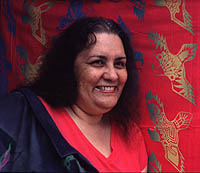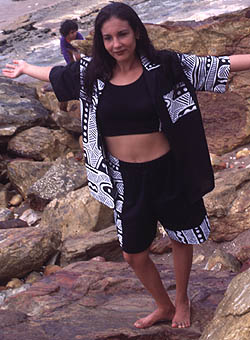|
Lenore
Dembski is a contemporary Aboriginal fashion designer
influencing current trends. Her designs feature textiles
designed and produced by Aboriginal and Torres Strait
Islanders and reflect her cultural heritage and contemporary
focus.
For
almost 30 years Lenore has been designing and manufacturing
clothing. Lenore's labels which feature men's, women's
and children's clothing suitable for resort, day and
evening wear, include:
- Lenore
Dembski Paperbark Woman (women's wear)
- Oakman
(men's wear)
- Aunty
Lenore (children's wear).
|
The
clothing she produces is made using fabric designed
by Aboriginal and Torres Strait Island people.
Lenore purchases fabrics from a pool of about
twenty designers and organises the manufacture
of garments. Lenore is also the owner of a retail
outlet, Paperbark Woman.
Lenore
Dembski also holds a number of other positions.
She is the Manager, Staff Development and Training
of the Aboriginal and Torres Strait Islander Commission
in Darwin and is a newly appointed member of the
Australia Council's Aboriginal and Torres Strait
Islander (ATSI) Arts Board. The Board assists
Aboriginal and Torres Strait Islander people to
"claim, control and enhance their cultural
inheritance". (McGauran, 2000: 2)
|

Lenore Dembski. Courtesy:
Lenore Dembski |
|
Paperbark
Woman: the history so far
Lenore Dembski was born in Darwin, and with the exception
of about four years in the early 1980s, has lived there
all her life. Lenore has been married for 24 years to
Andrew Dembski. Her family name is Calma.
Lenore
Dembski says the Paperbark Woman name comes from her
Aboriginal group, the Kungarakan people, who are known
as Paperbark people. Oakman comes from her husband's
name. Dembski is Polish and means Oaktree. As well as
designing and sewing the clothes herself, Lenore also
sub-contracts the sewing to several local clothing manufacturers
and individuals.
To
many locals, Lenore Dembski is known for her public
service work in the Aboriginal and Torres Strait Islander
employment and training area and her involvement with
Aboriginal and Torres Strait Islander organisations.
However, she was actually a designer and maker before
she even thought about a career in the public service.
At high school she was intending to go into the clothing
industry and had taken the entrance examination for
a Sydney design school. When she was not accepted she
arranged an apprenticeship with a local tailor. Her
father however, convinced her to stay at school and
complete Year 12. On completing school, he suggested
she join the public service and sew later. After 25
years, the later came in the year 2000 when she
opened her shop.
Sewing as a child
Lenore was taught to sew by her mother when she was
about eight. To start with, she made dolls' clothes
and costumes for plays put on by her sisters and friends.
She began sewing for herself and her brother and sisters
by the time she was twelve and started designing,
drafting and sewing clothes for other people by the
time she was thirteen. Lenore learnt some formal skills
in sewing when she did "Sewing" during first
year at Darwin High School. Between 15 and 18, Lenore
modelled in a number of fashion parades and worked
on weekends and school holidays for Woolworths selling
all forms of clothing, materials and haberdashery.
By
her mid-teens, Lenore knew how to do knitting, crocheting,
tatting, beadwork, tapestry, batik, tie dye, macrame,
applique, patchwork and various other art and craft
activities. She used an Elna SU sewing machine and
a Contesser overlocker. She attended a number of short
courses put on by Elna in applique and machine embroidery,
men's wear, swim wear, lingerie, and stretch materials.
In Adelaide in 1982, Lenore did a twelve hour course
to learn formal techniques in drafting.
End hot link
Lenore
formally started her sewing business in 1979 when she
moved to Adelaide. She manufactured children's clothes,
women's sportswear, lingerie, and curtains for several
outlets, designed bridal and after-five wear for individuals
and costumes for concerts. On returning to Darwin in
1984, Lenore sewed on a casual basis for family and
friends and did a small amount of children's wear for
several outlets.
In
1996, to coincide with the Aboriginal Development Unit's
project to help promote Aboriginal fabrics to designers
and the general public, Lenore started to actively produce
resort wear, and evening and glamour wear using Aboriginal
fabrics.

Water lily laces. Photo: courtesy
Lenore Dembski. |
Fashion
awards
In the 1996 Northern Territory (NT) Fashion Awards,
as part of a joint venture with three other designers:
Paul Rider, Barbara Smith and Katarina Hutcheson, Lenore
received second prize in Corporate Wear and Men's
Wear using textile designs by Barbara Smith and
Katarina Hutcheson.
In
the 1998 NT Fashion Awards, Lenore received third prize
in Our Territory, Our life style and won the
Chief Minister's Award for using the colours of the
Northern Territory flag. Both outfits were made using
the Snake design by Bede Tungatalum from Tiwi
Design.

Snake
shirt and shorts. Snake design by Bede Tungutalum
from Tiwi Design. Shirt and shorts designed by Paperbark
Woman. Photo: courtesy Lenore Dembski.
|
In
1998, Lenore also was runner up in the Australia
at its Best category at the Australian Gown of
the Year for a string bikini, top and skirt she
made using lycra printed in Melbourne, featuring the
Rain dreaming pattern from Ali Curung.
|
In
the 1998 Flair Fashion Awards in NSW, Lenore's
silk bridal wear, featuring the Body painting
design from Tiwi Design, was chosen as one of
125 garments out of a total of 350 entries to
be shown on the catwalk.
For
more information visit www.paperbarkwoman.com.au.
Activity
1. Briefly identify sources of inspiration for
the wedding dress. Explain the links between traditional
and contemporary design in the wedding dress.
2. Experiment with some instant body art. Copy
a design you have created onto an overhead transparency.
Ask someone to trace around your body on a large
sheet of paper. Project the image onto the paper
- instant body painting. Adjust the image by moving
the transparency. Trace the projected image onto
the paper. Consider how you could use this exercise
to design a garment.
|

Wedding
Body painting dress. Features fabric
designed by Tiwi Design. Photo: courtesy Lenore
Dembski. |
|
|